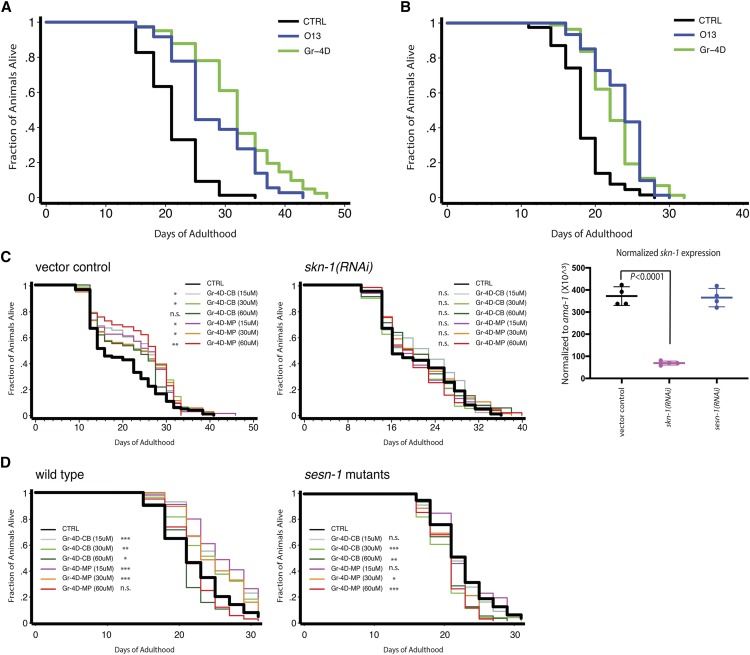Figure 4.
Extension of C. elegans’ lifespan by small molecules. Small molecules were analyzed for their ability to extend the lifespan of C. elegans. Two small molecules (Gr-4D, without cell toxicity; O13, with cell toxicity) that consistently extended lifespan in multiple independent assays are shown. A) Wild-type animals, grown in liquid, with FUDR to block progeny production, 20°C. Control, 21.2 ± 0.5 (mean ± SEM in days), n = 77/81 (observed/total); Gr-4D-treated, 31.9 ± 1.1 (50.5% increase), n = 41/41, P < 0.0001 (log-rank test); O13-treated, 28.1 ± 1.1 (32.5% increase), n = 36/36, P < 0.0001. B) Temperature-sensitive sterile mutant animals, grown on plates, without FUDR, 25°C then shifted to room temperature (∼22°C) as adults. Control, 18.4 ± 0.4, n = 67/80; Gr-4D-treated, 22.5 ± 0.4 (22.2% increase), n = 74/95, P < 0.0001 (log-rank test); O13-treated, 23.4 ± 0.4 (27.2% increase), n = 72/76, P < 0.0001 (see Supplemental Table 8 for details). C) The lifespan extension produced by Gr-4D requires skn-1. RNAi-sensitive mutants were fed with control vector or skn-1 RNAi bacteria and treated with Gr-4D (from two different vendors, CB = ChemBridge, MP = MolPort) at multiple doses. In parallel, RNAi-treated animals were collected for RT-qPCR analysis, which indicated that skn-1 mRNA level was reduced by ∼80% in these animals (normalized to ama-1, n = 4 each; one-way ANOVA, followed by Dunnett’s multiple comparison, P < 0.0001). In this experiment, Gr-4D extended lifespan of control animals by ∼15–20%. D) The lifespan extension produced by Gr-4D requires sesn-1. In this experiment, lower doses but not a high dose of Gr-4D extended lifespan of wild type by ∼10–17%. (The reason for this discrepancy was unclear). Log-rank test: *, P < 0.05; **, P < 0.01; ***, P < 0.001; n.s., not significant (see Supplemental Table 8 for details of lifespan data).

